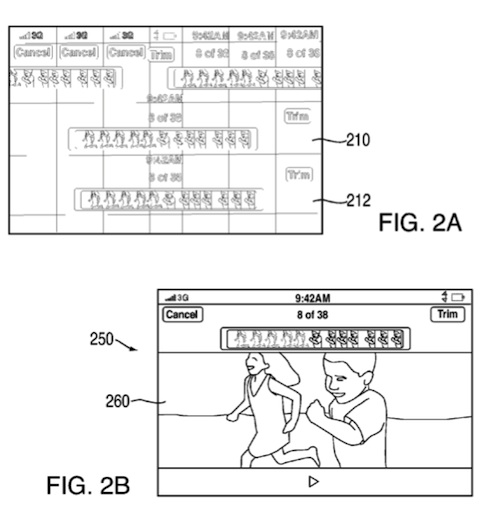A new Apple patent (number 2011010206285) for “obfuscating the display of information and removing the obfuscation using a filter” shows that Apple is considering glasses that would offer private viewing, most likely on an iOS device, but perhaps also on a Mac laptop.
The patent is directed to obfuscating a display to secure the display of information provided to a user. An electronic device can modulate the display of information using different approaches, including for example by adding artifacts or changing the color, frequency or polarity of displayed information, thus obfuscating the display. To view the displayed information, a user can place a filter between the user and the display (e.g., as part of glasses) such that the filter can remove or undo the obfuscation.
In some embodiments, the device can display different confidential information for several users simultaneously, where different obfuscation approaches are used for each user. This can allow several users to interact with the device simultaneously while ensuring that each user’s information remains confidential.The inventors are Andrew Hodge, Gloria Lin, Tyler Mincey and Benjamin Rottler.
Here’s Apple’s background and summary of the invention: “This is directed to systems and methods for adjusting the manner in which information is provided by a display such that only an authorized user having an appropriate filter can view the displayed information. In some embodiments, this is directed to simultaneously displaying different sets of information such that the different users can simultaneously and independently view different sets of information.
“Many electronic devices, including portable electronic devices, can include displays for providing information to users. The electronic device can include any suitable type of display, including for example a LED, LCD, OLED, plasma, projector, e-ink, or combinations of these types of display. Any suitable information can be provided on the display. For example, one or more of text, graphics and media can be provided on the display for the user.
“Any suitable application or process of the device can generate the information to be provided on the display. For example, one or more media applications, text generation applications, photo applications, communications application, web browsing applications, or combinations of these can provide information for the display.
“In some embodiment, the display can have a large viewing angle so that a user can view the information from positions other than straight ahead. While this may allow users to easily view displayed information, the information can also be visible to other people in the user’s environment. When a user is displaying confidential or personal information, however, a user may not wish that the information be easily visible to all. To prevent this, some users can place plastic screen over the display, where the screen reduces the viewing angle of the display to a very narrow angle substantially perpendicular to the display.
“This approach, however, does not prevent other people behind the user (e.g., within the narrow viewing angle) from viewing the information displayed by the device. In addition, the screen can greatly reduce the amount of light reaching the user from the display, and therefore decrease the user’s experience, and may force the user to sit directly opposite the display.
“This is directed to systems and methods for changing the manner in which information is provided on a display so that only a single authorized user can view the information when it is displayed. In particular, this is directed to providing a display that obscures or obfuscates information such that only a user with a corresponding filter (e.g., in glasses) can see the un-obscured information.
“An electronic device can include a display operative to provide information to a user. In some cases, a user may direct the electronic device to display confidential or private information. To prevent unauthorized users to view the information, for example over the authorized user’s shoulder, the electronic device can obfuscate the display of the information in one or more regions of the device.
“For example, the electronic device can add artifacts to the display to obscure portions of the displayed information. As another example, the electronic device can adjust display properties of the information (e.g., color or polarity) such that the information appears obscured. In some embodiments, the electronic device can apply a reversible transformation to the displayed information.
“To view the obfuscated information, the user can place a filter between the device display and the user’s eyes. The filter can correspond to the particular obfuscation approach used for securing the display of the information. In some embodiments, the filter can be static, such that only a fixed set of obfuscation processes work with the filter.
“Alternatively, the filter can be dynamic such that it can adjust the manner in which it filters based on the obfuscation process used by the electronic device. In some cases, a dynamic filter can be used to reverse a transformation applied to displayed information.
“The electronic device can determine which obfuscation process to use using any suitable approach. In some embodiments, the electronic device can identify a user or a filter, and select an obfuscation process that corresponds to the user or filter.
“For example, the electronic device can capture an image of a filter, and determine attributes of the filter from the image. As another example, the electronic device can receive from the filter an obfuscation process to use. As still another example, the filter can receive from the electronic device a reverse transformation to apply to displayed information.
“In some embodiments, the electronic device can instead or in addition adjust the viewing angle of regions of the display. The viewing angle for each region can be oriented away from the center of the of the device, and in some cases can change dynamically to follow a user’s position relative to the display (e.g., follow the user’s head). In some embodiments, several regions can each be associated with several viewing angles so that different users can simultaneously view different information privately on the display.”
— Dennis Sellers


